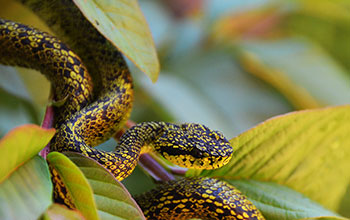Multimedia Gallery
Newly discovered Talamancan palm-pitviper
The newly discovered Talamancan palm-pitviper can be found in trees or high shrubs. Because its coloring is a characteristic it shares with its close relative the black-speckled palm-pitviper, it went unrecognized for more than 100 years.
More about this image
An international team of researchers solved a case of mistaken identity and discovered a new species of venomous snake.
The newly discovered Talamancan palm-pitviper, a striking green and black snake living in some of the most remote regions of Costa Rica, had gone unrecognized for more than 100 years because it shares characteristic coloring with its close relative the black-speckled palm-pitviper. It is a case of cryptic speciation, where two species look almost identical but are genetically different.
"It’s a really interesting phenomenon," said Christopher Parkinson, a University of Central Florida (UCF) biologist and professor who led the team that made the discovery. "It shows some of the complexities we deal with when cataloging biodiversity and underscores the importance of maintaining natural history collections. Discovering this species would not have been possible without the specimens housed in natural history museums."
Talamancan palm-pitvipers, a rather slender, small- to medium-sized pitviper, are found in trees, where their green and black pattern provides excellent camouflage. They average about 24 inches but can get as large as 30 inches. Researchers believe they only live in a 100 kilometer area in the north of Talamancan Cordillera in Costa Rica.
The team first realized they may be dealing with a new species in 2001, when they were conducting genetic analysis of the palm-pitviper clade and noticed some unusual genetic differences among the snakes they were studying. But finding specimens for further study would be difficult because these snakes live in high elevations, in low densities and are rare even in their natural habitat.
To overcome this hurdle, Tiffany Doan, first author on a paper published about their findings, utilized natural history collections at a number of places, including museums and universities, to generate the morphological data used in the project. Collections at these institutions contain thousands of reptile specimens representing decades of research. This enabled Doan and her colleagues to compare morphology of the suspect snakes to those of others, which had been placed in museum collections for 150 years. The team also collected tissue samples from additional specimens over the past 15 years, which they used to compare DNA of the potentially new snake species to the DNA from other snakes in Central America. Their findings concluded that the snake was indeed a new species.
Parkinson, who is an expert in venomous snakes, said, "This discovery highlights the necessity for strong conservation initiatives." Many undisturbed areas around the world are being developed before scientists get a chance to document their flora and fauna. "There’s no telling what other species are yet to be found and how they might benefit mankind," adds Parkinson.
This research was supported in part by National Science Foundation grant DEB 04-16000.
To learn more about this research, see the UCF news story UCF Led Team Discovers New Venomous Snake. (Date image taken: Unknown; date originally posted to NSF Multimedia Gallery: Oct. 4, 2016)
Credit: University of Central Florida
See other images like this on your iPhone or iPad download NSF Science Zone on the Apple App Store.
Images and other media in the National Science Foundation Multimedia Gallery are available for use in print and electronic material by NSF employees, members of the media, university staff, teachers and the general public. All media in the gallery are intended for personal, educational and nonprofit/non-commercial use only.
Images credited to the National Science Foundation, a federal agency, are in the public domain. The images were created by employees of the United States Government as part of their official duties or prepared by contractors as "works for hire" for NSF. You may freely use NSF-credited images and, at your discretion, credit NSF with a "Courtesy: National Science Foundation" notation.
Additional information about general usage can be found in Conditions.
Also Available:
Download the high-resolution JPG version of the image. (6.5 MB)
Use your mouse to right-click (Mac users may need to Ctrl-click) the link above and choose the option that will save the file or target to your computer.



 All images in this series
All images in this series